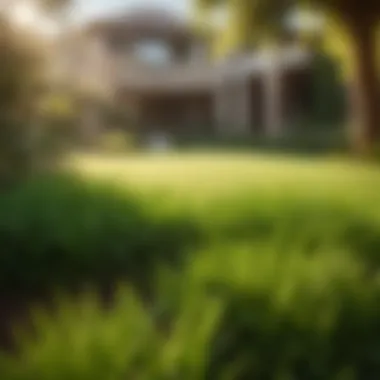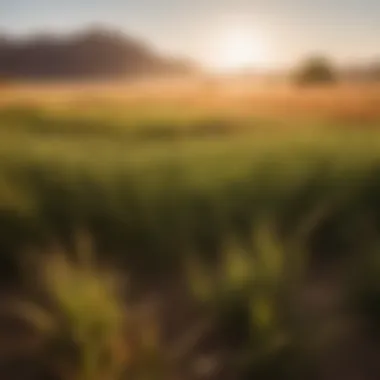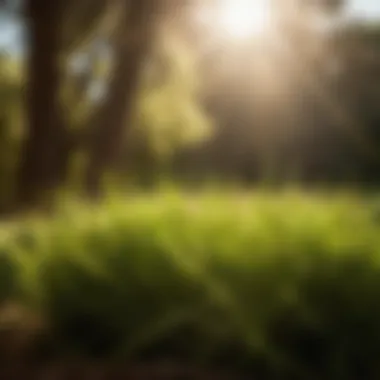In-Depth Exploration of Shade and Drought-Resistant Grasses for Sustainable Landscaping


Materials:
- Shade and drought-tolerant grass seeds (exact measurements vary depending on the desired coverage area)
- Potting soil with excellent drainage properties
- Garden shovel for soil preparation
- Rake for smoothing out soil
- Garden hose or watering can for irrigation
- Mulch for moisture retention
DIY Steps:
-
Prepare the Soil: Select the area for planting and remove any weeds or debris. Use the garden shovel to turn over the soil and break up any clumps.
-
Sow the Seeds: Evenly distribute the shade and drought-tolerant grass seeds across the prepared soil. Lightly press the seeds into the soil to ensure good seed-to-soil contact.
-
Water Thoroughly: Use the garden hose or watering can to thoroughly water the seeded area. Keep the soil consistently moist but not waterlogged.
-
Mulch Application: Apply a layer of mulch over the seeded area to help retain moisture and protect the seeds from harsh weather conditions.
Technical Aspects:
- Timing: Spring and early fall are the optimal seasons for planting shade and drought-tolerant grass.
- Tools: Apart from the mentioned tools, a pH tester can be used to ensure the soil is suitable for seeding.
- Critical Techniques: Ensuring proper soil preparation and consistent watering are crucial for successful germination.
DIY Project Process:


-
Installation Method: Monitor the seeded area regularly and water as needed to keep the soil moist but not waterlogged.
-
Key Techniques: Avoid walking on the freshly seeded area to prevent compaction and hinder seed growth.
-
Timings: Germination typically occurs within 7-21 days, depending on the grass variety. Patience is key during this phase.
Troubleshooting Tips:


- Sparse Growth: If the grass growth is uneven, overseeding can help fill in bare patches.
- Excessive Watering: Adjust watering frequency if the soil becomes waterlogged to prevent seed rot.
Introduction


In the realm of landscaping, the choice of grass plays a pivotal role in shaping the aesthetic appeal and sustainability of outdoor spaces. As we delve into the nuanced world of shade and drought-tolerant grass in this comprehensive guide, we unlock the key to transforming challenging environmental conditions into opportunities for vibrant and resilient landscapes. Understanding the characteristics, benefits, and cultivation techniques of these hardy plants is essential for individuals seeking to create sustainable and visually pleasing outdoor environments.
Defining Shade and Drought Tolerant Grass
Shade and drought-tolerant grass varieties exhibit remarkable adaptability to environments with limited sunlight and water availability. These grasses are specially designed by nature to thrive in conditions where traditional species may struggle to survive. Through their unique mechanisms, such as enhanced water retention capabilities and resilience to heat and sun exposure, they ensure lush greenery even in the face of adversity. By defining shade and drought-tolerant grass, we gain a deeper appreciation for the innate resilience and specialized features that make these species stand out in the world of landscaping.
Significance of Opting for Resilient Grass Varieties
Opting for resilient shade and drought-tolerant grass varieties carries immense significance for both environmental and practical reasons. By choosing these grasses, individuals contribute to water conservation efforts as these plants require less irrigation compared to traditional turf. Moreover, the low maintenance requirements of resilient grass varieties reduce the need for chemical inputs, thus promoting environmental sustainability. The intrinsic resilience of these grasses also translates to cost-effectiveness and long-term durability, offering homeowners a low-effort, high-reward landscaping solution. Embracing resilient grass varieties signifies a commitment to sustainable and environmentally conscious practices, setting the foundation for beautiful landscapes that thrive amidst challenging conditions.
Characteristics of Shade and Drought Tolerant Grass
Shade and drought tolerant grass play a crucial role in sustainable landscaping practices, offering a myriad of benefits and unique characteristics that set them apart from traditional grass varieties. Understanding the specific elements that define shade and drought tolerant grass is essential for individuals looking to create resilient and visually appealing landscapes in challenging environmental conditions.
One of the key benefits of shade and drought tolerant grass is their adaptability to low light conditions. These grass varieties have evolved mechanisms to thrive even in areas with minimal sunlight, making them ideal for shaded yards or gardens. By exploring their adaptability to low light conditions, individuals can make informed decisions when selecting grass species that will flourish in shaded areas.
Water retention mechanisms are another critical aspect of shade and drought tolerant grass. These grasses have developed efficient ways to retain water, minimizing the need for frequent irrigation and ensuring their survival during dry periods. Understanding these mechanisms is essential for maintaining healthy grass cover without excessive water usage.
Furthermore, the heat and sun tolerance of shade and drought tolerant grass make them well-suited for hot and arid climates. These grass varieties can withstand intense sunlight and high temperatures, offering durability and longevity in challenging environmental settings. By considering their heat and sun tolerance, individuals can choose grass species that will thrive in sunny locations.
Root system resilience is also a crucial characteristic of shade and drought tolerant grass. These grass varieties develop robust root systems that help them access water and nutrients efficiently, contributing to their overall resilience and longevity. By understanding the importance of root system resilience, individuals can implement effective maintenance practices to support healthy grass growth.
Benefits of Shade and Drought Tolerant Grass
Shade and drought-tolerant grass varieties offer a myriad of benefits that cater to the needs of housewives and homeowners looking to enhance their landscapes sustainably. One crucial advantage lies in water conservation, where these grass types excel in efficiently utilizing water resources, thereby contributing to environmental efforts.
Water Conservation
Water conservation stands at the forefront of the benefits associated with shade and drought-tolerant grass. These specialized grass species have inherent qualities that enable them to thrive with minimal water input. By selecting these grass types, homeowners can significantly reduce their overall water consumption for lawn maintenance, promoting sustainability and responsible water usage practices.
Low Maintenance Requirements
Shade and drought-tolerant grass varieties possess low maintenance requirements, making them an ideal choice for individuals seeking aesthetically pleasing landscapes without the need for excessive upkeep. These grasses have developed resilience to challenging environmental conditions, reducing the need for constant monitoring and interventions. Thus, homeowners can enjoy lush greenery without the hassle of frequent mowing, fertilizing, or watering.
Environmental Sustainability
Embracing shade and drought-tolerant grass contributes to environmental sustainability on multiple levels. By selecting these grass varieties, homeowners actively participate in conserving water resources, reducing chemical inputs, and fostering biodiversity in their outdoor spaces. This eco-conscious approach aligns with modern landscaping trends that emphasize sustainability and environmental awareness, making shade and drought-tolerant grass a cornerstone of a green and thriving ecosystem.
Cultivation and Care Tips
In this article on exploring shade and drought-tolerant grass, the section on cultivation and care tips plays a pivotal role in guiding individuals on the selection and maintenance of resilient grass varieties. Understanding the specific elements, benefits, and considerations of cultivation and care tips is crucial for ensuring the successful growth of shade and drought-tolerant grass.
Selecting the Right Grass Species
Fescue Grass
Fescue grass, known for its adaptability to various light conditions, contributes significantly to the overall goal of establishing sustainable landscapes. Its key characteristic lies in its ability to thrive in both shade and sun, making it a versatile and popular choice for individuals seeking resilient grass varieties. The unique feature of Fescue Grass is its deep root system, which enhances its drought tolerance but may require more frequent mowing. While Fescue Grass offers excellent benefits such as low water requirements and minimal maintenance, it's important to note that it may struggle in extremely hot conditions.
Buffalo Grass
Buffalo grass stands out for its drought tolerance and low maintenance needs, aligning well with the core theme of the article. Its key characteristic is its rapid spread and quick establishment, making it a beneficial and popular choice for sustainable landscapes. The unique feature of Buffalo Grass is its fine texture and dense growth, providing a lush appearance with minimal water usage. However, its disadvantage lies in being less shade-tolerant compared to other grass species. In the context of this article, Buffalo Grass excels in areas with ample sunlight and low water availability.
Zoysia Grass
Zoysia Grass brings a unique set of qualities to the table, enhancing the overall objective of promoting resilient grass varieties. Its key characteristic includes excellent heat and drought tolerance, making it a sought-after option for challenging environmental conditions. The unique feature of Zoysia Grass is its dense growth pattern, creating a thick carpet-like appearance in lawns. While Zoysia Grass offers advantages such as high wear tolerance and weed resistance, its slower establishment and invasive nature might be considered as potential drawbacks in the context of this article.
Optimal Planting Practices
Proper planting practices are essential for the successful growth of shade and drought-tolerant grass. When planting these grass species, it is imperative to consider factors such as soil preparation, planting depth, watering frequency, and post-planting care to ensure healthy establishment and growth.
Maintenance Guidelines
Once shade and drought-tolerant grass species are planted, adherence to specific maintenance guidelines is crucial for their long-term health and vitality. These guidelines may include proper watering techniques, mowing practices, fertilization schedules, and pest control measures tailored to the characteristics of selected grass species. Consistent and appropriate maintenance is key to sustaining the beauty and resilience of shade and drought-tolerant grass in varying environmental conditions.
Popular Varieties of Shade and Drought Tolerant Grass
In this section of the comprehensive guide on exploring shade and drought-tolerant grass, we delve into the significance of understanding and implementing popular varieties of such resilient grass in creating sustainable and visually appealing landscapes in challenging environmental conditions. Popular varieties are crucial as they offer a range of benefits and considerations that cater to different preferences and requirements of homeowners.
St. Augustine Grass
St. Augustine grass, known for its lush and vibrant appearance, is a popular choice among homeowners seeking a visually striking lawn. This variety thrives in warm climates and exhibits excellent shade tolerance, making it a suitable option for areas with partial sunlight. Its dense growth pattern also contributes to weed suppression, reducing the need for herbicides. When properly maintained, St. Augustine grass forms a thick carpet-like cover that enhances the overall aesthetic appeal of the landscape.
Tall Fescue
Tall fescue is a cool-season grass variety known for its durability and adaptability to a wide range of soil types. With its deep root system, tall fescue exhibits exceptional drought tolerance, requiring minimal irrigation compared to other grass types. Its ability to withstand foot traffic and recover quickly from damage makes it a popular choice for high-traffic areas in residential lawns. Additionally, tall fescue maintains its green color throughout the year, providing year-round visual appeal.
Bermuda Grass
Bermuda grass is a warm-season grass prized for its resilience and rapid growth rate. This variety thrives in full sun and exhibits excellent heat tolerance, making it well-suited for hot and arid climates. Bermuda grass spreads quickly through aboveground stems, enabling it to fill in bare patches and create a lush, dense lawn. Its low water requirements and tolerance to frequent mowing make it a low-maintenance choice for homeowners looking to achieve a picturesque lawn without extensive care.
Conclusion
In the realm of exploring shade and drought-tolerant grass, the significance of embracing sustainable landscaping practices cannot be overlooked. As we navigate through the intricacies of selecting resilient grass varieties and understanding their unique characteristics, the conclusion serves as a fundamental pillar in our journey towards creating sustainable and visually appealing landscapes even amidst challenging environmental conditions.
Embracing Sustainable Landscaping Practices
When it comes to embracing sustainable landscaping practices, it is imperative to consider the long-term benefits and implications. Sustainable landscaping involves utilizing environmentally friendly techniques and materials that contribute to the overall health of the ecosystem while minimizing negative impacts on the environment. One of the key aspects of sustainable landscaping is water conservation, which is crucial in regions susceptible to drought conditions. By opting for shade and drought-tolerant grass varieties, individuals can significantly reduce water usage in their landscaping endeavors, promoting conservation and efficiency. Furthermore, the low maintenance requirements of these resilient grasses not only save time and effort for homeowners but also decrease the reliance on pesticides and fertilizers, promoting a healthier environment for both humans and wildlife. Additionally, by choosing to cultivate shade and drought-tolerant grass, individuals are actively contributing to environmental sustainability. These grass varieties require fewer inputs in terms of water, leading to decreased water consumption and runoff, ultimately benefiting the local ecosystem. Through sustainable landscaping practices, individuals can play a significant role in conserving natural resources, reducing pollution, and fostering biodiversity in their surroundings. Embracing sustainable landscaping practices is not just a trend; it is a conscious choice towards creating a greener and more resilient future for generations to come.



